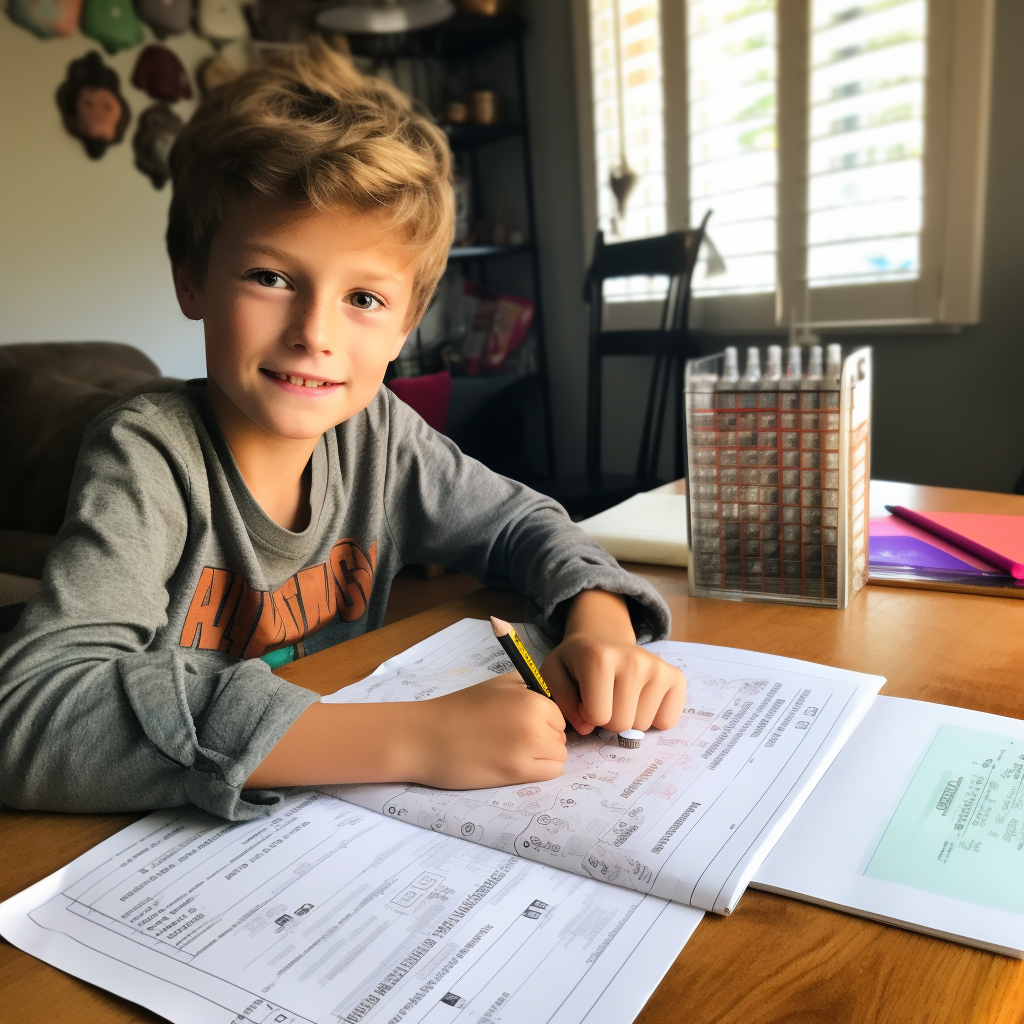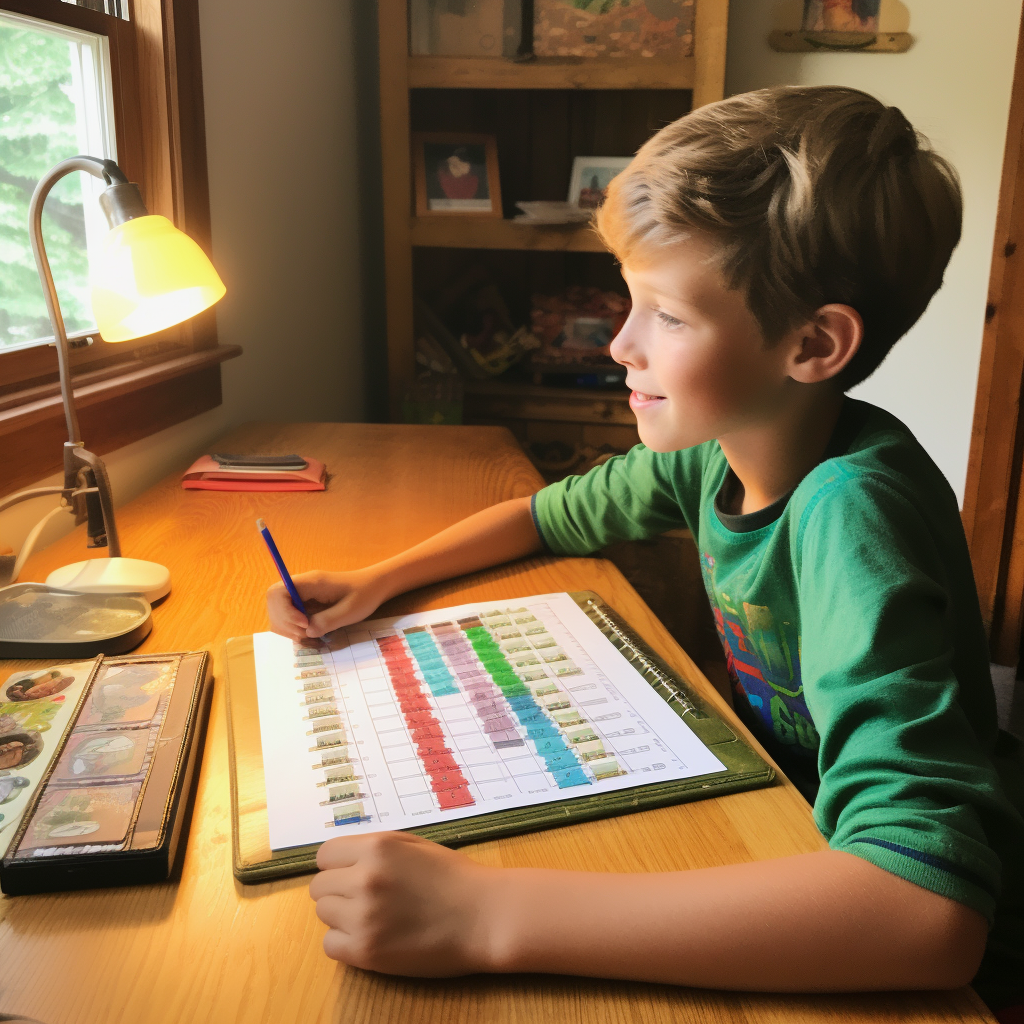Creating a homeschooling schedule that suits your child’s learning style can be a daunting challenge. For one thing, it can be difficult to assess whether the materials and teaching methods being used are actually effective in meeting their individual needs. Furthermore, finding the right balance between giving them enough support and ensuring that they are adequately challenged can be tough. Nevertheless, with a little bit of research and thoughtfulness, building a homeschooling schedule that caters to your child’s learning style can ultimately be both manageable and successful.
The first step to creating a successful homeschooling schedule is determining your child’s learning style. Consult resources like Khan Academy, Varsity Tutors, and Time 4 Learning to get a better understanding of your child’s individual learning style and what works best to engage them. In addition, talk to parents of other homeschoolers and take into account your child’s personal preferences when designing the schedule.
Once you have a grasp on your child’s learning style, communicate with them about their preferences for pacing, topics, and specific activities. It’s also a good idea to spend some time paying attention to how they naturally learn and make note of skills, concepts, or strategies that come easily to them and may not require explicit instruction. Incorporating opportunity for play, exploration, and practice into the curriculum is also important. Give them plenty of chances to demonstrate their understanding through hands-on activities.

Definition of Homeschooling
Homeschooling is an educational choice in which parents take responsibility for educating their children instead of sending them to traditional school. Homeschooling is commonly used at elementary and secondary school levels and can be done by utilizing a combination of activities, including online classes, discussion-based lessons, hands-on projects, and field visits.
When creating a homeschooling schedule, it is important to determine your child’s learning style and to tailor the educational approach to best fit their needs. Start by evaluating your child’s interests and skills and create a lesson plan that incorporates those topics in an engaging way. Once you have a general outline, you can break down the learning into smaller chunks of material, such as 30-45 minutes of daily instruction or a few hours each day after short breaks and recess. Adjust your homeschooling schedule as needed to ensure that your child stays interested and focused. It is also equally important to provide breaks throughout the day away from the learning materials to keep your child energized and motivated.
Benefits of Homeschooling
To ensure that your child’s homeschooling schedule suits his/her learning style, there are several benefits to consider.
First, homeschooling offers the flexibility and customization to tailor content to your child’s needs. With access to online resources and tailored curricula, you can create lessons and learning experiences that are engaging and individually tailored to your child’s interests and strengths.
Second, homeschooling allows for a more relaxed learning environment with fewer distractions. Your child’s individualized schedule allows them to move at their own pace, break up tasks into smaller chunks, and receive feedback and guidance when needed.
Third, homeschooling enables you to teach your child in the way that best suits their learning style. Children learn differently. With homeschooling, you can provide different types of learning experiences, such as textbook learning, hands-on activities, virtual classes, and field trips, as well as give them the opportunity to develop relationships with people of diverse backgrounds and experiences.
Fourth, homeschooling allows your child to be self-directed in their learning. This can help foster creativity and develop critical thinking skills. Ultimately, creating a schedule that best suits your child’s learning style and meets their educational needs will help them to thrive.

Identifying Your Child’s Learning Style
Creating a homeschooling schedule that suits your child’s learning style requires first understanding what their learning style is. Everyone learns differently, and recognizing your child’s learning style can help you create an effective learning environment for them.
There are three main learning styles: Visual, Auditory, and Kinesthetic.
Visual learners like to process information by viewing it. They can easily read information or look at images and remember it without hearing it. Visual learners need pictures, diagrams, charts, videos, and other visual tools to help them process information.
Auditory learners like to take in information via sound or voice. They may find it either easy or hard to process information from a book, but they will excel if the lesson is explained to them via a lecture, podcast, or other verbal form.
Kinesthetic learners prefer to learn through doing. They are more active in their learning, and may prefer to take part in experiments or hands-on activities.
When creating a homeschooling schedule for your child, it’s important to take their learning style into account. If your child is a visual learner, you may want to include visuals like charts, videos, or pictures in their lesson plans so they can absorb information more quickly. For an auditory learner, podcasts or speaking exercises can be beneficial. And for a kinesthetic learner, plan activities that will engage them physically.
Different Types of Learning Styles
When it comes to creating a homeschooling schedule that suits your child’s learning style, the key is to identify your child’s preferred learning style in order to make the homeschooling process as effective and enjoyable as possible. There are many types of learning styles, including visual, auditory, kinesthetic, verbal, logical, and social learners. Visual learners learn best when presented with images, diagrams, and other visual aids. Auditory learners learn best when listening to lectures or discussions. Kinesthetic learners learn best when engaging in hands-on activities and physical exploration. Verbal learners learn best when given verbal instructions and clear directions. Logical learners learn through analysis, categorization, and systematization. Social learners learn best when working in groups and in social settings.
In order to create a homeschooling schedule that suits your child’s learning style, you will need to tailor the educational activities and lessons to your child’s style. For example, if you have a visual learner, you should include activities and lessons that involve pictures, videos, and diagrams. If you have an auditory learner, you can do lessons that involve lectures, discussions, and audio recordings. If you have a kinesthetic learner, activities that involve physical activities, experiments, and other hands-on activities are essential. And if you have a verbal learner, you can include tasks that involve oral presentations, storytelling, and other verbal activities.
Assessing Your Child’s Preferred Learning Style
When creating a homeschooling schedule, it’s important to assess your child’s preferred learning style. Every child learns differently, so it’s important to consider your child’s individual needs and interests when creating a homeschooling schedule.
To assess your child’s preferred learning style, observe the way your child learns best in different settings. Does your child prefer one-on-one instruction or independent study? Is your child more visual or auditory? Does your child need hands-on activities or more time to work through material independently?
Once you have a sense of your child’s preferred learning style, it’s important to create a homeschooling schedule that takes advantage of these tendencies. For example, if your child belongs to the visual learning style, you might design your schedule in accordance with the types of activities that would interest and engage them. This could involve incorporating activities such as art projects, digital lessons, and virtual field trips into the curriculum. For a student who prefers more hands-on learning, you might include science experiments, cooking, or construction projects into the curriculum.
It can also be beneficial to switch up the types of activities and incorporate different learning styles throughout the day. This can help to keep the student engaged and motivated. Make sure to tailor the schedule to fit your child’s individual needs and interests. With careful planning, it’s possible to create an effective homeschooling schedule that suits your child’s learning style.

Using Your Child’s Learning Style to Set Up A Basic Homeschool Schedule
Creating a homeschooling schedule that fits with your child’s learning style can be very beneficial in helping your child make the most of their homeschooling experience. Here are a few considerations to take into account when creating a schedule for your child:
1. Establish the Learning Goals: Establishing learning goals for your child is essential when it comes to setting up a homeschooling schedule. Determine what subjects and topics you wish to focus on in a particular academic year and then map out a plan so that your child is gradually able to master them.
2. Consider Your Child’s Learning Style: Every child is different and chances are that your child has a specific learning style that works best for them. If your child is an auditory learner, for example, you may want to consider incorporating more activities like lectures or discussions into your homeschooling schedule. For a visual learner, activities that require your child to draw or create visual aids may be more beneficial.
3. Establish “Down Time”: While it’s important to keep your child focused and productive, make sure that there is also time for relaxation and play. This can include taking outings, going on nature walks, hosting play dates, etc. This will help your child remain engaged in the homeschooling process.
4. Plan in Advance: When it comes to creating a homeschooling schedule, planning in advance is essential.
Designing a Flexible Schedule
Creating a homeschooling schedule that suits your child’s learning style will require flexibility. Start by exploring your child’s learning style – their strengths, interests, and motivations. Consider their energy level throughout the day and structure the schedule accordingly. Then, create a base daily schedule with times for structured activities, breaks, and free time. Be sure to also include time for outside activities, hobbies, and socialization. Finally, be prepared to adjust the schedule as needed. Allow space for flexibility and changes throughout the day to accommodate your child’s needs. For example, if they are having difficulty with a particular activity, you can shift to another activity they will find more engaging. Or if they need more time to finish a task, you can extend the allotted time. With your personalized, flexible homeschooling schedule, your child will have the best chance to succeed in their learning environment.
Adding Educational Activities Customized to Learning Style
When creating a homeschooling schedule that suits your child’s learning style, you should consider incorporating educational activities that are tailored to your child’s specific needs and interests. For example, if your child is a visual learner, they may benefit from activities such as field trips, videos, diagrams, and powerpoint presentations. If your child is an auditory learner they may benefit from activities such as lectures, discussions, or debates. For tactile-kinesthetic learners, activities such as experiments, crafts, or hands-on construction activities may be beneficial. By adapting these activities to suit your child’s individual needs and interests, you can create a homeschooling schedule that works best for them.
Establishing Good Habits With the Schedule
Creating a homeschooling schedule to fit a child’s learning style is an important step in ensuring successful homeschooling. It allows the child to have a sense of structure, and that structure helps to create good habits. Setting up a routine allows the child to become accustomed to the expectations for their learning and gives them a chance to become engaged with the concepts that will be taught. There are many ways to create a schedule that will best fit the needs of the child, such as, daily checklists and blocks of time devoted to a single subject.
Including set times for breaks and activities that the child enjoys will also help to ensure a positive homeschooling experience for the child. Taking breaks between tasks and allowing for a few minutes of free play will help the child reset and be better prepared for the next section of the day’s learning. Creating a schedule with specific times for certain topics and breaks encourages the child to build good habits such as organization and problem-solving capabilities.
Making sure to adjust the schedule if it’s not working to the child’s learning style is also important. It’s important to take the time to observe the child’s behavior and take into account their preferences. Creating a schedule that works best for the child can lead to more successful homeschooling and make homeschooling more enjoyable for both the parent and the child.
Setting Up Goals and Incentives
Setting up goals and incentives can be a great motivating factor when creating a homeschooling schedule that suits your child’s learning style. You can start by breaking larger tasks into smaller, achievable goals and provide immediate rewards when those goals are achieved. You can provide rewards like extra free time for desirable activities, special trips, a certain type of treat, or a reward your child personally values as incentive to complete the tasks with a high level of quality. Additionally, you may involve your child in the goal setting process, allowing them to personalize the rewards. By providing appropriate incentives, your child is more likely to take ownership of their homeschooling and to work to create a learning experience that works for them.
Establishing Good Time Management
Good time management is essential to creating a successful homeschooling schedule that fits with your child’s learning style. You need to establish a plan that will provide balance between instruction/curriculum, independent work and breaks for your child. Start by creating a weekly schedule with clearly defined blocks of time for each homeschooling task, such as curriculum lessons, individual assignments, and hands-on activities.
It’s also important to take into account your child’s natural rhythm of work and learning. Some kids operate best in a very structured environment while others thrive on spontaneous learning opportunities. Design activities and tasks that can accommodate different learning styles to make the most out of the time your student has for learning.
Finally, try to incorporate some flexibility into your homeschooling schedule. That way, if some activities take longer or shorter than anticipated, you can easily adjust. It’s also a good idea to include some downtime regularly so your child can rest and recharge his or her batteries. All these strategies can help you create a successful, personalized homeschooling schedule that fits with your student’s learning style.

Conclusion
When creating a homeschooling schedule for your child that suits their learning style, it’s important to pay attention to their particular strengths and weaknesses. Ask your child what their preference is, and try to incorporate some fun activities while still teaching them according to the educational standards. Think about what kind of daily/weekly schedule might work best, including times and activities for study, play, exercise, rest, and mindfulness. Allow for some flexibility and adjust the schedule according to your child’s needs. Finally, build in time for yourself to plan, research, and prepare lessons or activities ahead of time. With proper communication and a well-thought-out plan, it is possible to create a homeschooling schedule that works for you and your child.
Recap of Benefits of Homeschooling
There are many benefits to homeschooling, and many parents choose to create a homeschooling schedule that suits their children’s individual learning style. Homeschooled children are known to develop strong relationships with their family by spending more time together and they often have deeper appreciation of lifelong learning.
When creating a homeschooling schedule, it’s important to take into consideration your child’s learning style. A child’s learning style consists of the way they best absorb and process information. Knowing this can help you develop an effective homeschooling schedule that is tailored to your child’s needs. You can also leverage your child’s special interests and talents by creating educational activities that will help them excel.
When designing the homeschooling schedule, you should include a mix of hands-on activities, independent study, group work, and outdoor activities. Set a flexible daily schedule with core subjects, such as language arts, science, social studies, and math, along with other specialized classes such as music, coding, or foreign language. Allow breaks throughout the day and make sure to include plenty of physical activities so they can stay energized and engaged.
Designing a homeschooling schedule that suits your child’s learning style takes patience, but can result in a more enriched and fulfilling educational experience.
Summary of Tips for Implementing a Homeschool Schedule Tailored to Learning Style
When creating a homeschooling schedule that suits your child’s unique learning style, here are some tips to keep in mind:
* Establish a routine. Decide on a consistent schedule of when school will start and end each day.
* Create a flexible schedule. Depending on the day or activity, provide some flexibility in when tasks are completed each day.
* Incorporate breaks and outdoor activities. Allow for needed breaks to recharge mentally and physically. Get moving by introducing outdoor activities as part of the homeschooling schedule.
* Focus on topics that engage your child’s interests. Prioritize topics that are most exciting and entertaining to help keep your child engaged.
* Personalize specific activities. Find ways to personalize activities to accommodate your child’s learning style i.e. hands-on activities, visual activities, etc.
* Monitor progress. Check in periodically to see how your child is progressing and make adjustments where needed.
* Allow for collaboration. Give your child opportunities to collaborate and learn from other homeschooling families.
* Engage in different learning methods. Introduce different learning methods to keep the learning experience dynamic.
* Focus on playtime. Make sure your child has time for their other interests and playtime.
